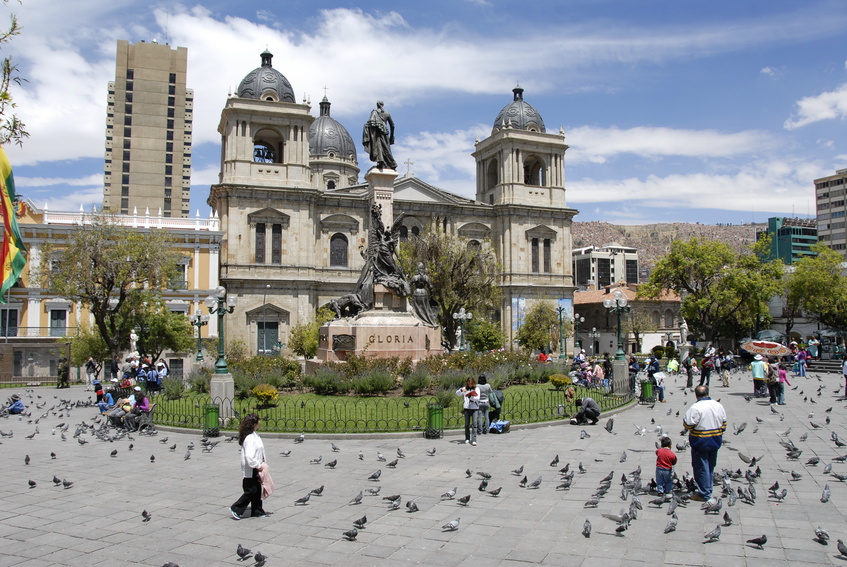One of the New 7 Wonders Cities
La Paz
Pedro Domingo Murillo Province, Bolivia
La Paz, (/lɑː ˈpɑːz/), officially known as Nuestra Señora de La Paz (Spanish pronunciation: [ˈnwes.tɾa seˈɲoɾa ðe la pas]; English: Our Lady of Peace), also named Chuqi Yapu (Chuquiago) in Aymara, is the seat of government of the Plurinational State of Bolivia. With an estimated 789,541 residents as of 2015, La Paz is the third-most populous city (after Santa Cruz de la Sierra and El Alto). Its metropolitan area, which is formed by La Paz, El Alto and Viacha, make the most populous urban area in Bolivia, with a population of 2.3 million inhabitants. It is also the capital of the La Paz Department. The city, located in west-central Bolivia, 68 km (42 mi) southeast of Lake Titicaca, is set in a canyon created by the Choqueyapu River and sits in a bowl-like depression surrounded by the high mountains of the altiplano. Overlooking the city is towering triple-peaked Illimani, which is always snow-covered and can be seen from many parts of the city. At an elevation of roughly 3,650 m (11,975 ft) above sea level, La Paz is the highest capital city in the world. Due to its altitude, La Paz has an unusual subtropical highland climate, with rainy summers and dry winters.
La Paz was founded on October 20, 1548 by the Spanish conquistador Captain Alonso de Mendoza at the site of the Inca settlement of Laja as a connecting point between the commercial routes that led from Potosí and Oruro to Lima; the full name of the city was originally Nuestra Señora de La Paz (meaning Our Lady of Peace) in commemoration of the restoration of peace following the insurrection of Gonzalo Pizarro and fellow conquistadors against the first viceroy of Peru. The city was later moved to its present location in the valley of Chuquiago Marka. La Paz was originally under Spanish rule when it belonged to the Viceroyalty of the Río de la Plata. Since its founding, the city experienced numerous revolts, the most significant ones being in 1781, when the indigenous leader and independence activist Túpac Katari laid siege to the city for a total of six months and on July 16, 1809 when the Bolivian patriot Pedro Domingo Murillo ignited a revolution of independence marking the beginning of the Spanish American Wars of Independence.
As the seat of the government of Bolivia, La Paz is the site of the Palacio Quemado, the Presidential Palace and seat of the Bolivian executive power, the Plurinational Legislative Assembly and numerous government departments and agencies. Sucre remains, however, the constitutional capital of Bolivia and retains the judicial power. The city also hosts numerous foreign embassies as well as international missions in the country. La Paz is an important political, administrative, economic, and sports center of Bolivia; it was responsible for generating 25% of Bolivia’s Gross Domestic Product and serves as the headquarters for numerous Bolivian companies and industries.
La Paz is also an important cultural center of Bolivia, as it hosts several landmarks belonging to the colonial times, such as the San Francisco Church, the Metropolitan Cathedral, the Plaza Murillo and the Jaén Street. The city is also renowned for its unique markets, particularly the Witches’ Market, and for its vibrant nightlife. Its unusual topography offers unique views of the city and the surrounding mountains of the Cordillera Real from numerous natural viewing points. La Paz is also home to both the longest and highest urban cable car network in the world. In May 2015, it was officially recognized as one of the New7Wonders Cities together with Vigan, Doha, Durban, Havana and Kuala Lumpur. La Paz is listed on the Global Cities Index 2015, and is considered a global city type “Gamma” by GaWC.
Bolivia
Interesting Facts
La Paz
Population
757.18 thousand
Elevation above sea level
3600 metre
Area
472 km2
Instance of
city, big city & capital
